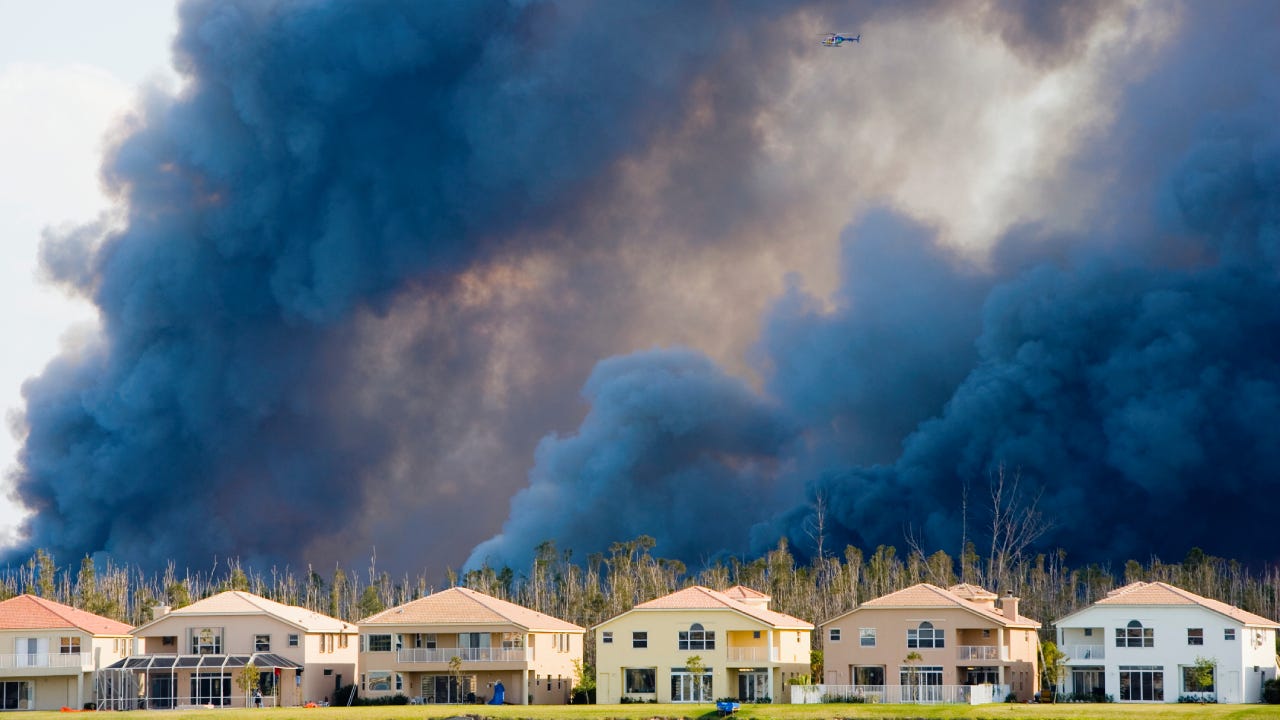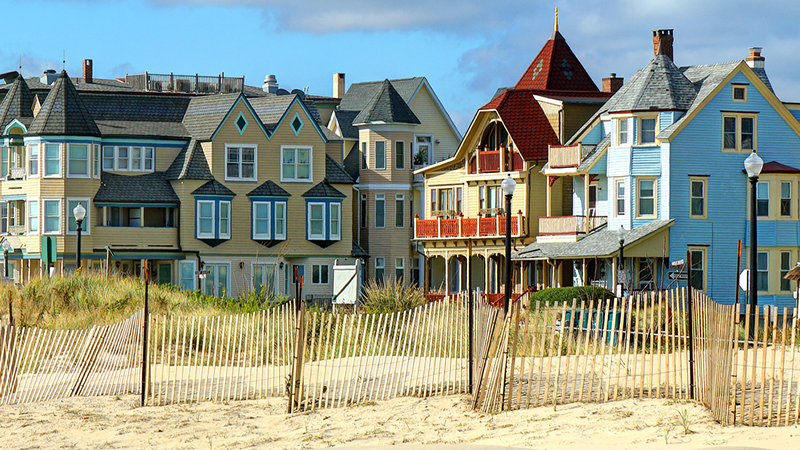How to find affordable homeowners insurance in a high-risk fire zone




Key takeaways
- The number of counties identified as having a high risk of wildfires has increased in recent years.
- Roughly one-third of the U.S. population lives in counties with a high wildfire risk.
- Homeowners living in areas with high wildfire risk may have difficulty finding adequate home insurance coverage and face higher premiums.
- Shopping around with multiple carriers, looking for discounts and reducing your home's fire exposure may help you find more affordable coverage.
- Installing a fire-resistant roof, retrofitting your home and creating a defensible area may reduce your home's burn risk.
- Wildfire may be an excluded peril in insurance policies for homes in high-risk areas.
Wildfires can be terrifying and destructive, and they may be happening more often. In 2024, the metrics used to calculate wildfire risks for homeowners were updated with modern climate data and methodologies by Wildfire Risk to Communities, an organization run by the U.S. Forest Service. The new data indicates that more than a third of the U.S. population lives in counties with a high risk of wildfires. The organization estimated that more than 48 million structures in the U.S. are built in counties with a high risk of wildfire. To help combat rising insurance rates, Bankrate compiled information that may assist you in securing home insurance for fire zone areas, along with tips to help reduce the risk of fire damage to your home.
How fire risk affects homeowners insurance costs
According to the National Interagency Fire Center (NIFC), 56,580 wildfires affected over 2.6 million acres in the U.S. in 2023. These numbers are lower than in 2022, where 68,988 fires affected 7.5 million acres. From 2022 to 2023, the U.S. experienced $3.2 billion in damage from wildfires. Areas prone to this type of wildfire risk create a challenging insurance landscape.
When determining home insurance rates, most insurance companies will review the home’s location and the surrounding area’s features. Neighborhoods close to wildfire zones or in wildland urban interface locations are more at risk of damage or total loss. The higher the disaster risk, the higher the home insurance premium typically is. As rising temperatures and more frequent droughts spread across the U.S., areas that were once unaffected by wildfires are becoming at risk for this type of natural disaster.
Due to the cost of disaster payouts, higher premiums passed down from reinsurance companies and uncontrollable future wildfire losses, some of the biggest insurance companies, like State Farm and Allstate, have stopped issuing new homeowners insurance policies in California. Farmers, USAA, Travelers, Nationwide and Chubb are also limiting new home policies in the state, making it difficult to find California home insurance in high fire risk areas. With fewer companies sharing the risk, the remaining insurers may start limiting availability to certain ZIP codes and increasing premiums to maintain financial solvency.
How to get home insurance in high fire risk areas
While it may be more difficult to find homeowners insurance in fire-prone areas, there are options. If you’re struggling to find affordable homeowners insurance in a high-risk fire area, or are having trouble finding insurance entirely, these tips may help:
- Ask your neighbors. It may be helpful to ask neighbors for the names of the companies that insure their homes. By doing this, you can build a list of potential carriers that may also be willing to insure your home. Plus, you can generally assume the insurer offers policies in your ZIP code, although you won’t know for certain until you request a quote.
- Shop around with more than one carrier. It may help to keep your options open when it comes to finding carriers. If you struggle to find an insurance company that’s willing to cover your home, or if you’re getting quotes that are much higher than you expected, it may pay to inquire about coverage from both large, nationally available carriers and small regional home insurance companies. Working with an independent insurance broker may help you know which carriers to start with.
- Take advantage of discount opportunities. Some insurers may offer discounts for bundling your home and auto insurance, paying your premium in full or upgrading your roof. If you want to save on your home insurance policy, it may pay to inquire about the discount opportunities from the insurers or agents you are getting quotes from.
- Consider a FAIR Plan. While in many cases a temporary solution, purchasing homeowners insurance coverage via your state’s FAIR Plan may be one way to obtain coverage while you search for a permanent option. However, FAIR Plan coverage may not be as robust as a private insurer policy and may also be more expensive than private coverage.
- Reduce your home’s burn risk. Installing fire prevention features may help you find more affordable coverage by reducing your home’s fire risk. Some updates can be simple, like swapping the mulch in your garden for gravel or more expensive, such as updating your siding to a fire-resistant material.
How to reduce the risk to your home in a fire-prone area
In addition to helping you secure lower home insurance rates, reducing your home’s fire exposure may also help reduce your losses in the event of a fire. Some strategies for reducing your home’s burn risk include:
- Installing a fire-resistant roof: Fire-resistant roofs could help with mitigating fire damage to your home. Materials that typically qualify for Class A roof coverings include concrete or clay tiles, fiberglass asphalt shingles or metal roofs.
- Retrofit your home: CalFire, California’s Department of Forestry and Fire Protection, has a list of ways you can retrofit your home to protect against wildfire. You may be able to retrofit vents, windows, walls and even rain gutters and fences to reduce your fire exposure risk.
- Create a defensible area around your home: The key to this strategy is to remove any vegetation that might be flammable away from your home. This could include clearing away plants and shrubs from windows, decks, balconies and stairs as well as removing other potential hazards near the exterior of the home that might catch on fire, including mulch, pine straw, firewood or debris.
- Plan for water access: When preparing to evacuate your home, fill tubs with water and place buckets of water in different areas of the house. For the exterior, connect long garden hoses or sprinklers to water spigots for firefighters to immediately access additional water.
Your fire prevention strategy will look different based on your home type and location. Speaking with your local fire department may help you find other ways to protect your home, such as making sure your address is clearly marked and visible from the street. There may also be local or state grants available to help with the costs of fire-prevention measures.
Frequently asked questions
-
The best home insurance carrier for homes in high-risk fire zones is likely one that will offer the coverage types you need at a cost you can afford. Finding cheap coverage may be more difficult if you live in a high-risk area, but comparing quotes from carriers may help you identify which company could offer you coverage at a reasonable price. Speaking with a local insurance broker or your neighbors may give you a place to start when looking for the best companies writing policies in your region.
-
California, Arizona, Texas and Nevada are some of the most at-risk states for wildfires. However, as climate change exacerbates droughts and heat waves, wildfire risk is becoming a more pressing issue in parts of nearly every state. Within states, homes located near wildland urban interface areas, or areas where houses are located near wilderness areas, may be especially at risk for wildfire damage. The U.S. Department of Agriculture and Forest Service created this tool to allow homeowners to evaluate wildfire exposure in their region.
-
Fire is one of the covered perils in a standard homeowners insurance policy, and this usually includes wildland fires. However, many insurance companies exclude loss from wildfires for homes located in high-risk areas. This means that while your home may have coverage from electrical and other types of fires, you may need a separate wildfire policy. You may want to check with your insurance agent for clarification regarding fire coverage if you live in a state prone to wildfires.
-
Homeowners insurance companies are required to send out nonrenewal notices before your policy term ends and explain why they are not renewing your coverage. The actual timeframe in which this notice is required may differ depending on your state regulations. Also, depending on the reason for the nonrenewal, you may be able to resolve any concerns the insurer has in order to continue your coverage. If not, you can use the time between receiving the nonrenewal notice and the termination date of your current policy to shop around for new home insurance coverage.
You may also like

Home warranty vs. homeowners insurance

Best renters insurance in New Jersey

How much homeowners insurance do I need?

How to save on homeowners insurance premiums in 2025
